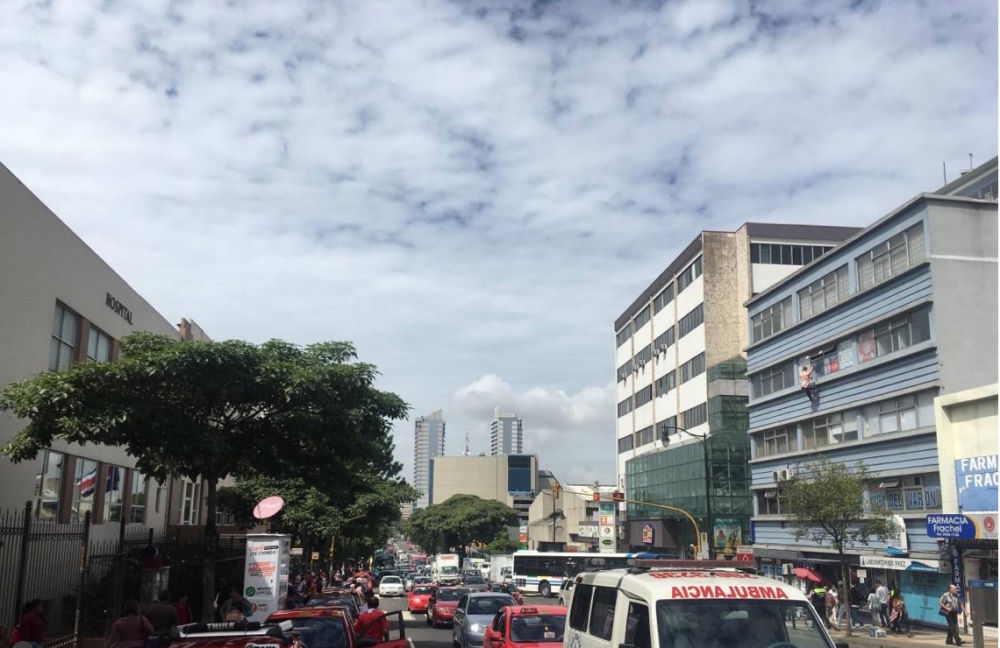
SEBASTIAN RODRIGUEZ, of Thomson Reuters Foundation, reports from Central America…
Costa Rica’s president has launched an economy-wide plan to decarbonize the country by 2050, saying the Central American nation aims to show other nations what is possible to address climate change.
Costa Rica’s environment minister, Carlos Manuel Rodríguez, said that if the plan is achieved, his grandchildren in 2035 will have the same carbon footprint as his grandparents did in the 1940s – and by 2050 his grandchildren will have none at all.
“Not only are we going to reduce that footprint but we are going to bring many benefits with it”, Rodríguez said.

A view of street traffic in San Jose, Costa Rica, in November, 2017. PICTURE: Sebastian Rodriguez/Thomson Reuters Foundation.
But Jairo Quirós, an electrical energy researcher at the University of Costa Rica, warned the plan would be challenging, and “should be viewed with some caution”.
Under the roadmap launched recently, Costa Rica by 2050 would achieve “zero net emissions”, meaning it would produce no more emissions than it can offset through things such as maintaining and expanding its extensive forests.
“Not only are we going to reduce that footprint but we are going to bring many benefits with it.”
– Carlos Manuel Rodríguez, Costa Rica’s environment minister.
Such emission cuts – which many countries are expected to try to achieve in the second half of the century – are key to holding increases in global temperature to well under two degrees Celsius, the goal of the 2015 Paris Agreement on climate change.
The Costa Rica plan aims to allow the country to continue growing economically while cutting greenhouse gases. The country’s economy grew at three per cent last year, according to World Bank data.
Christiana Figueres, the Costa Rican former UN climate chief, called the goal “unprecedented” in international politics.
Only the government of the tiny Marshall Islands also has laid out a detailed plan to achieve that goal, but “they still do not have the whole plan articulated sector by sector”, Figueres said in an interview with the Thomson Reuters Foundation.
President Carlos Alvarado noted that while Costa Rica represents only a tiny share of the world’s climate-changing emissions, the experiments tried in the plan could be a model for other nations.
“We can be that example… we have to inspire people,” he said at the plan’s launch, noting the country was “doing what’s right”.
But Quirós, of the University of Costa Rica, warned the plan will take hard work to achieve.
Some goals, he said, such as ensuring all buses and taxis run on electricity by 2050, may be difficult, not least because the changes will be expensive.
“Although one tends to see that [electric bus] prices are falling over time, there is a lot of uncertainty regarding that,” he said.
Transport today creates about 40 per cent of Costa Rica’s climate-changing emissions, making it the main source of them, according to the National Meteorological Institute.
To cut transport emissions, the plan aims to modernise public transport, including through the creation of an electric train line.
The new line would connect 15 of the 31 neighbourhoods in the San Jose metropolitan area and carry about 250,000 of the area’s one million people each day, according to the Costa Rican Institute of Railways.
Construction on the lines is expected to start in 2022, according to the institute.
“A modern and efficient public transport system has a much greater impact on achieving decarbonisation than just electrifying our vehicle fleet,” said Claudia Dobles, the president’s wife and coordinator of the transport chapter of the plan.
Dobles, an architect and urban planner, has been coordinating many of the country’s public transport efficiency initiatives, including the electric train project and a reorganisation of bus routes.
Under Costa Rica’s decarbonisation plan, the number of cars circulating in urban areas would be cut by half by 2040, the environment minister said.
By 2035, 70 per cent of the country’s buses would be electric and 25 per cent of its cars, Rodríguez added.

Costa Rican President Carlos Alvarado leaves the Costa Rican Museum of Art, accompanied by his wife and son, after launching a country-wide decarbonisation plan on 24th February. PICTURE: Sebastian Rodriguez/Thomson Reuters Foundation
Juan Ignacio Del Valle, director of operations for hydrogen-powered transport company Ad Astra Rocket Company, said the plan still needs work on some issues, such as cargo transport.
Technological innovation will be needed to achieve some of the goals, he said.
Ad Astra has been testing hydrogen fuel cell buses in Costa Rica for about eight years – a fuel switch that is “vaguely” contemplated in the new plan, Del Valle said.
Hydrogen transport will need more research, but it could prove the most efficient option in areas where electric vehicles fall short, including carrying cargo and for other heavy transport, he said.
For Costa Rica, the potential political battles around decarbonizing its economy are less than in many other countries because it does not have a fossil fuel extraction industry, Rodriguez said.
But dependence on oil revenue could still cause roadblocks for the switch. Fuel taxes, vehicle import taxes and driving taxes, for instance, account for about 12 per cent of government revenue, the minister said.
To phase out fossil fuels without slashing government income, the government will need to push for “green tax reform” to find new revenue sources, he said – something that could take time, as it would need legislative approval.
Under the decarbonisation plan, the country’s state-owned petroleum distributor would change course and begin research on alternative fuels, such as hydrogen and biofuels, and look at helping fossil fuel workers move to clean energy jobs.
The plan also calls for further expanding forests – though at the moment most of the money to pay for that comes from taxes on fossil fuels, Rodríguez admitted.
The country already has one of the region’s strongest reputations for forest protection.
“In the 1960s and 70s, Costa Rica had the highest per capita deforestation rate in the world. We have managed not only to stop deforestation but to double forest coverage…”
– Carlos Manuel Rodríguez.
“In the 1960s and 70s, Costa Rica had the highest per capita deforestation rate in the world. We have managed not only to stop deforestation but to double forest coverage” as the economy grew, Rodríguez said.
Forests that covered 25 per cent of the country in the 1980s covered more than 50 per cent of it by 2013, according to data from the State of the Nation report, assembled by the country’s public universities.
Over that period, the country’s GDP grew from $US4 billion in 1983 to $US57 billion in 2013.
Costa Rica has already carried out some of the needed decarbonisation work, officials said.
Last year, 98 per cent of the country’s electricity came from renewable sources, according to the Costa Rican Electricity Institute, the state-owned company in charge of electricity generation and distribution.
Quirós, the University of Costa Rica researcher, said the country’s plan, while “a little utopic” was clearly “a step in the right direction”.
“It’s good to be ambitious,” he said.
Figueres said she believed the the country faced a “hard task” achieving its ambitious aims, but predicted it would “lead to a transformation like no other we’ve seen in decades”.





